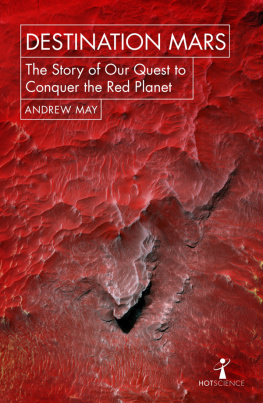Epilogue
Twenty years after Viking we are finally going back, with no fewer than ten missions planned for the period between 1996 and 2003. In November 1996, the American Mars Pathfinder (APF) is scheduled for launch. If all goes well, it will land in July 1997 at the Ares--Tiu Valles outflow channels (19.5 N, 32.8 W) and will deploy a small robotic rover called Sojourner to explore the Ares Vallis floodplain---a site, incidentally, very close to that originally planned for the Viking 1 landing in 1976.
Mars Global Surveyor (MGS) an orbiter scheduled for launch at the same time, will arrive in Martian orbit in August 1997 and will begin mapping the planet in January 1998. A Russian mission consisting of an orbiter and two landers will at Mars in October 1997.
It is likely that human explorers will follow eventually---perhaps as soon as the middle of the twenty-first century. If and when they do, they will owe much to the Mars of romance, to Schiaparelli, Lowell, Wells, Burroughs, and the rest. We have only now begun to awaken from our dream of Mars, the fire opal we have so long sought through our telescopes, to see it as it really is. The warm hues of the Martian deserts prove to be as deceptive as the pure polar pink of an Arctic sunset, and belie the really terrible reality. Their apparent warmth is only that of our imaginations, which they have so long fired. Still, with its great volcanoes, canyons, and dry riverbeds, Mars remains a fascinating, even if a lifeless, world. And its exploration has only just begun.
Appendix 1: Oppositions of Mars, 1901--2035
The table below gives the opposition date, the planet's position in the sky in terms of its right ascension (RA; hour angle from the first point of Aries) and its declination north or south of the equator (the latter is particularly important because, for northern observatories, a far southerly declination interferes with observation of the planet, which must then be viewed through a longer path of the Earth's atmosphere); the apparent size of the disk in seconds of arc; and the distance of the planet in astronomical units (1 a.u. = Earth-Sun distance). Owing to the slight inclination of Mars's orbit to that of the Earth, the minimum separation between the two bodies can actually occur a few days before or after the opposition date.
| Opposition date | RA | Declination | Disk
(seconds of arc) | Distance
(a.u.) |
|---|
| 1901 Feb 22 | 10h 26m | +14 32' | 13.8" | 0.678 |
| 1903 Mar 29 | 12h 32m | -00 05' | 14.8" | 0.640 |
| 1905 May 8 | 15h 00m | -16 57' | 17.3" | 0.543 |
| 1907 July 6 | 19h 01m | -27 59' | 22.7" | 0.411 |
| 1909 Sept 24 | 00h 10m | -04 13' | 23.8" | 0.392 |
| 1911 Nov 25 | 03h 58m | +21 43' | 18.0" | 0.517 |
| 1914 Jan 5 | 07h 05m | +26 33' | 15.1" | 0.625 |
| 1916 Feb 10 | 09h 36m | +19 08' | 14.0" | 0.675 |
| 1918 Mar 15 | 11h 44m | +05 55' | 14.0" | 0.662 |
| 1920 Apr 21 | 13h 57m | -10 21' | 15.8" | 0.588 |
| 1922 June 10 | 17h 11m | -25 55' | 20.1" | 0.462 |
| 1924 Aug 23 | 22h 19m | -17 40' | 25.1" | 0.373 |
| 1926 Nov 4 | 02h 36m | +14 26' | 20.2" | 0.465 |
| 1928 Dec 21 | 05h 58m | +26 39' | 15.8" | 0.589 |
| 1931 Jan 27 | 08h 42m | +22 54' | 14.0" | 0.663 |
| 1933 Mar 1 | 10h 59m | +11 26' | 14.0" | 0.675 |
| 1935 Apr 6 | 13h 03m | -03 52' | 15.1" | 0.624 |
| 1937 May 19 | 15h 43m | -20 39' | 18.0" | 0.515 |
| 1939 July 23 | 20h 13m | -26 24' | 24.1" | 0.389 |
| 1941 Oct 10 | 01h 07m | +03 29' | 22.7" | 0.414 |
| 1943 Dec 5 | 04h 44m | +24 24' | 17.3" | 0.545 |
| 1946 Jan 14 | 07h 44m | +25 35' | 14.8" | 0.641 |
| 1948 Feb 17 | 10h 07m | +16 25' | 13.8" | 0.678 |
| 1950 Mar 23 | 12h 13m | +02 20' | 14.4" | 0.651 |
| 1952 May 1 | 14h 34m | -14 17' | 16.6" | 0.564 |
| 1954 June 24 | 18h 12m | -27 41' | 21.6" | 0.433 |
| 1956 Sept 10 | 23h 26m | -10 07' | 24.8" | 0.379 |
| 1958 Nov 16 | 03h 25m | +19 08' | 19.1" | 0.494 |
| 1960 Dec 30 | 06h 39m | +26 49' | 15.5" | 0.610 |
| 1963 Feb 4 | 09h 15m | +20 42' | 14.0" | 0.671 |
| 1965 Mar 9 | 11h 25m | +08 08' | 14.0" | 0.669 |
| 1967 Apr 15 | 13h 35m | -07 43' | 15.5" | 0.605 |
| 1969 May 31 | 16h 32m | -23 56' | 19.4" | 0.486 |
| 1971 Aug 10 | 21h 27m | -22 15' | 24.8" | 0.376 |
| 1973 Oct 25 | 02h 00m | +10 17' | 21.2" | 0.441 |
| 1975 Dec 15 | 05h 29m | +26 02' | 16.2" | 0.570 |
| 1978 Jan 21 | 08h 20m | +24 06' | 14.4" | 0.654 |
| 1980 Feb 25 | 10h 37m | +13 27' | 13.8" | 0.677 |
| 1982 Mar 31 | 12h 43m | -01 21' | 14.8" | 0.637 |
| 1984 May 11 | 15h 13m | -18 05' | 17.3" | 0.537 |
| 1986 Jul 10 | 19h 20m | -27 44' | 23.0" | 0.406 |
| 1988 Sep 28 | 00h 27m | -02 06' | 23.8" | 0.396 |
| 1990 Nov 27 | 04h 13m | +22 28' | 18.0" | 0.523 |
| 1993 Jan 7 | 07h 19m | +26 16' | 14.8" | 0.628 |
| 1995 Feb 12 | 09h 47m | +18 11' | 13.8" | 0.676 |
| 1997 Mar 17 | 11h 54m | +04 41' | 14.0" | 0.661 |
| 1999 Apr 24 | 14h 09m | -11 37' | 16.2" | 0.583 |
| 2001 Jun 13 | 17h 28m | -26 30' | 20.5" | 0.456 |
| 2003 Aug 28 | 22h 38m | -15 48' | 25.1" | 0.373 |
| 2005 Nov 7 | 02h 51m | +15 53' | 19.8" | 0.470 |
| 2007 Dec 28 | 06h 12m | +26 46' | 15.5" | 0.600 |
| 2010 Jan 29 | 08h 54m | +22 09' | 14.0" | 0.664 |
| 2012 Mar 3 | 11h 52m | +10 17' | 14.0" | 0.674 |
| 2014 Apr 8 | 13h 14m | -05 08' | 15.1" | 0.621 |
| 2016 May 22 | 15h 58m | -21 39' | 18.4" | 0.509 |
| 2018 Jul 27 | 20h 33m | -25 30' | 24.1" | 0.386 |
| 2020 Oct 13 | 01h 22m | +05 26' | 22.3" | 0.419 |
| 2022 Dec 8 | 04h 59m | +25 00' | 16.9" | 0.550 |
| 2025 Jan 16 | 07h 56m | +25 07' | 14.4" | 0.643 |
| 2027 Feb 19 | 10h 18m | +15 23' | 13.8" | 0.678 |
| 2029 Mar 25 | 12h 23m | +01 04' | 14.4" | 0.649 |
| 2031 May 4 | 14h 46m |












